
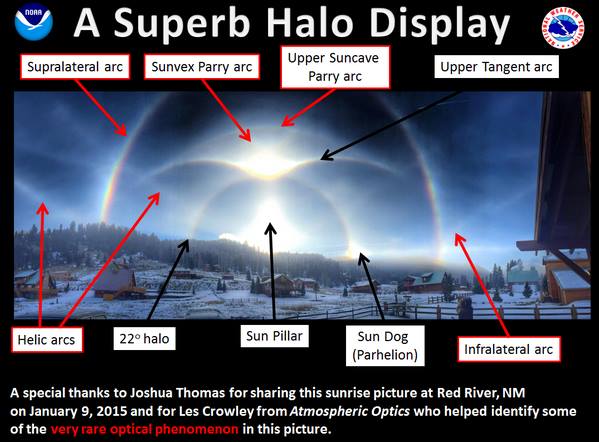
Ice halos are caused by ice crystals in the upper atmosphere, which both refract and reflect sunlight or moonlight.
Nguồn: EarthSky
************************************************************************************
HIện tuợgn quang học thật lạ trên bầu trời của New Mexico , Mỹ
Nguyên nhân hình thành nên các vòng tròn màu, vòng cung và những điểm trên bầu trời là sự tương tác giữa ánh sáng Mặt Trời hoặc Mặt Trăng với tinh thể băng đá ơ lửng trong bầu khí quyển. Tinh thể băng đá phản xạ và khúc xạ ánh sáng theo một cách nào đó dưới điều kiện thời tiết lạnh.
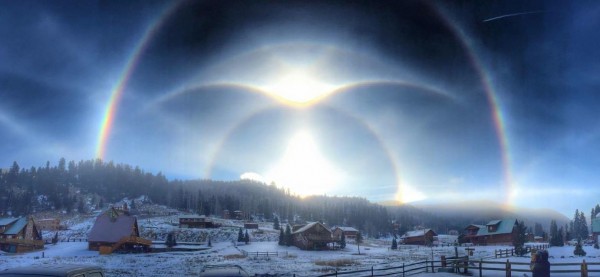
Viral Spell cho hay, quầng băng xuất hiện khi luồng gió băng giá ở Bắc Cực tiếp tục thổi trên khắp lãnh thổ nước Mỹ vài ngày qua, khiến nhiệt độ ở nhiều thành phố giảm mạnh xuống dưới mức đóng băng
(sưu tầm)
************************************************************************************
What makes a halo around the sun or moon?
What makes a halo around the sun or moon?
A ring or circle of light around the sun or moon is called a halo by scientists
A ring or circle of light around the sun or moon is called a halo by scientists. We get many messages throughout each year from people who’ve just spotted a ring around the sun or moon. People want to know: what causes a halo around the sun or moon? Follow the links below to learn more about lunar and solar halos.
What makes a halo around the sun or moon? There’s an old weather saying: ring around the moon means rain soon. There’s truth to this saying, because high cirrus clouds often come before a storm. Notice in these photos that the sky looks fairly clear. After all, you can see the sun or moon. And yet halos are a sign of high thin cirrus clouds drifting 20,000 feet or more above our heads.
These clouds contain millions of tiny ice crystals. The halos you see are caused by both refraction, or splitting of light, and also by reflection, or glints of light from these ice crystals. The crystals have to be oriented and positioned just so with respect to your eye, in order for the halo to appear.
That’s why, like rainbows, halos around the sun – or moon – are personal. Everyone sees their own particular halo, made by their own particular ice crystals, which are different from the ice crystals making the halo of the person standing next to you.
If you see a halo, notice this! Because moonlight isn’t very bright, lunar halos are mostly colorless, but you might notice more red on the inside and more blue on the outside of the halo. These colors are more noticeable in halos around the sun. If you do see a halo around the moon or sun, notice that the inner edge is sharp, while the outer edge is more diffuse. Also, notice that the sky surrounding the halo is darker than the rest of the sky
Bottom line: Halos around the sun or moon happen when high, thin cirrus clouds are drifting high above your head. Tiny ice crystals in Earth’s atmosphere cause the halos. They do this by refracting and reflecting the light. Lunar halos are signs that storms are nearby
A ring or circle of light around the sun or moon is called a halo by scientists. We get many messages throughout each year from people who’ve just spotted a ring around the sun or moon. People want to know: what causes a halo around the sun or moon? Follow the links below to learn more about lunar and solar halos.
What makes a halo around the sun or moon? There’s an old weather saying: ring around the moon means rain soon. There’s truth to this saying, because high cirrus clouds often come before a storm. Notice in these photos that the sky looks fairly clear. After all, you can see the sun or moon. And yet halos are a sign of high thin cirrus clouds drifting 20,000 feet or more above our heads.
These clouds contain millions of tiny ice crystals. The halos you see are caused by both refraction, or splitting of light, and also by reflection, or glints of light from these ice crystals. The crystals have to be oriented and positioned just so with respect to your eye, in order for the halo to appear.
That’s why, like rainbows, halos around the sun – or moon – are personal. Everyone sees their own particular halo, made by their own particular ice crystals, which are different from the ice crystals making the halo of the person standing next to you.
If you see a halo, notice this! Because moonlight isn’t very bright, lunar halos are mostly colorless, but you might notice more red on the inside and more blue on the outside of the halo. These colors are more noticeable in halos around the sun. If you do see a halo around the moon or sun, notice that the inner edge is sharp, while the outer edge is more diffuse. Also, notice that the sky surrounding the halo is darker than the rest of the sky
Bottom line: Halos around the sun or moon happen when high, thin cirrus clouds are drifting high above your head. Tiny ice crystals in Earth’s atmosphere cause the halos. They do this by refracting and reflecting the light. Lunar halos are signs that storms are nearby
Halo around the sun, seen from Sweden on April 24, 2014 and captured by Fotograf Goran Strand.
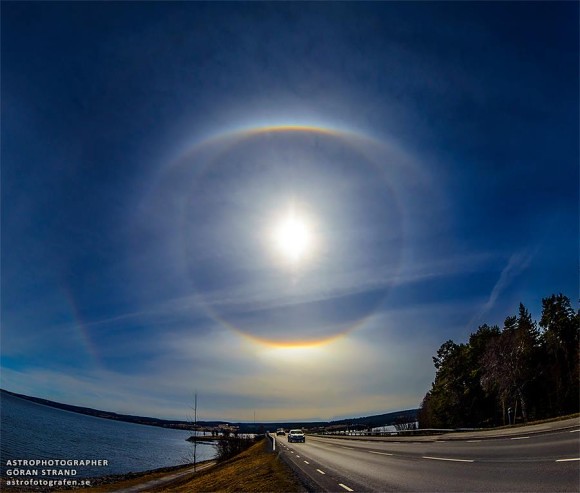
This halo above wheat fields in November, 2014 captured by Abhinav Singhai
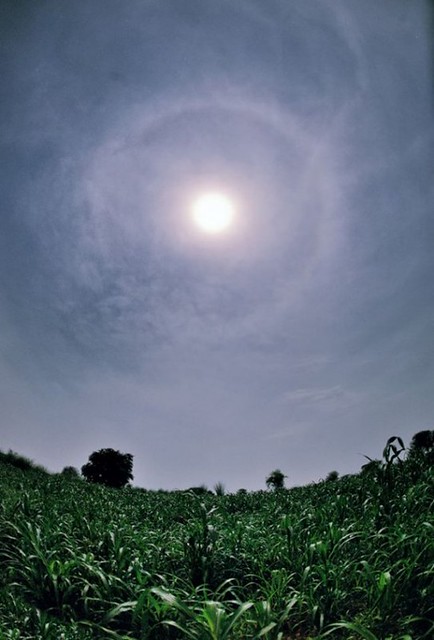
this image of a halo around the sun in Normandy, France in April, 2014 captured by Jean Marie Andre Delaporte

Solar halo seen May 14, 2013 in Monmouth, NJ captured by Stacey Baker-Bruno

Moon halo, with Jupiter on the edge of the halo, seen December, 2012 captured by Danny Crocker Jensen in Wardsville, Missouri.


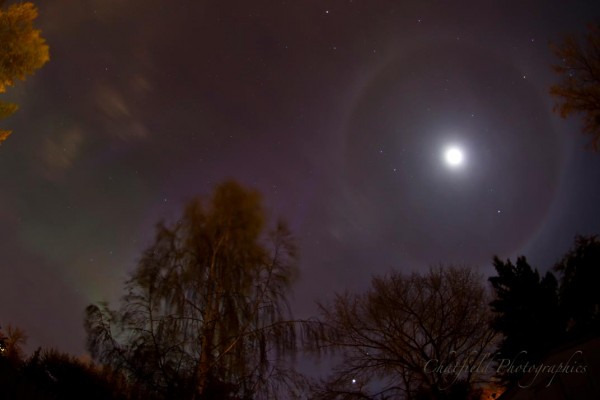
Sun halo seen in Tucson, Arizona in September, 2012 captured by Sean Parker
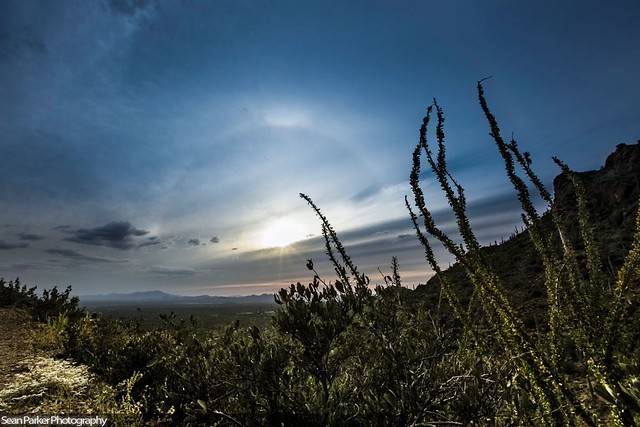
Sun halo seen in Washington state in May, 2012 captured by Sean Abbasi

Sun halo in May, 2012 captured by Nonya Justagirl


This halo above wheat fields in November, 2014 captured by Abhinav Singhai

this image of a halo around the sun in Normandy, France in April, 2014 captured by Jean Marie Andre Delaporte

Solar halo seen May 14, 2013 in Monmouth, NJ captured by Stacey Baker-Bruno

Moon halo, with Jupiter on the edge of the halo, seen December, 2012 captured by Danny Crocker Jensen in Wardsville, Missouri.

Halos around the sun and moon are associated with storms. On the night Superstorm Sandy made landfall in 2012, lunar halos were seen as far west in the U.S. as the state of Washington. Susan Jensen in Odessa, Washington saw and captured this delicate halo, as Sandy was carving its path of destruction along the U.S. East Coast

Lunar halo – with greenish northern lights on the left – as seen on the morning of October 8, 2012 captured by Colin Chatfield in Saskatoon, Saskatchewan, Canada

Sun halo seen in Tucson, Arizona in September, 2012 captured by Sean Parker

Sun halo seen in Washington state in May, 2012 captured by Sean Abbasi

Sun halo in May, 2012 captured by Nonya Justagirl

Nguồn: EarthSky

No comments:
Post a Comment